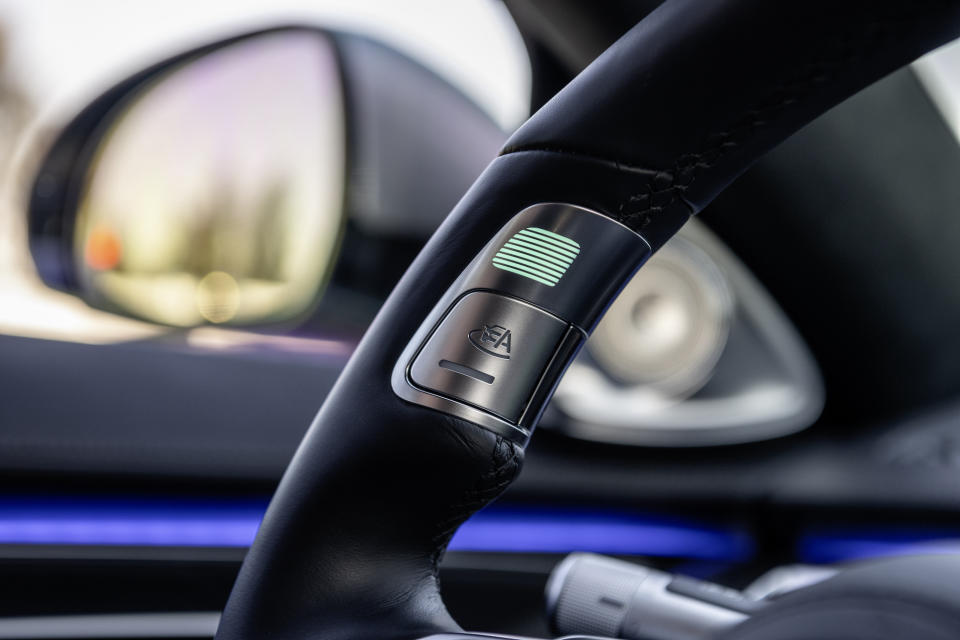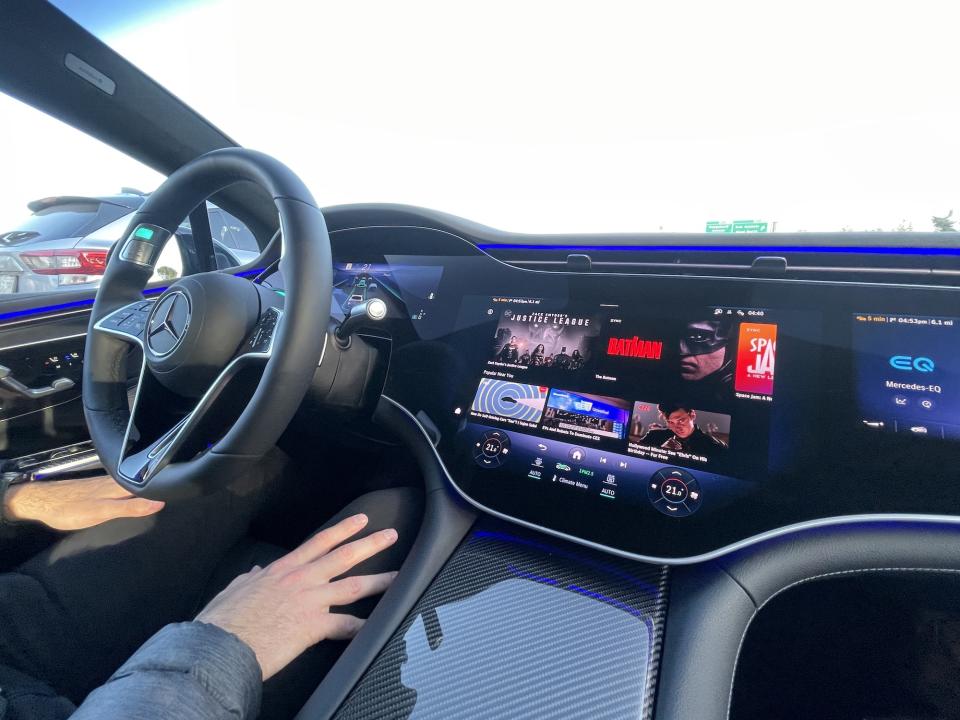First drive: Navigating LA freeways with Mercedes' hands-off, eyes-off automated driving system
Time, as they say, is money. Mercedes-Benz is looking to put some time back in your pocket with the advent of its automated driving system that will let drivers stream a movie, text or talk to a passenger without watching the road ahead or having their hands on the wheel.
And what better way to see what all the fuss -- or not -- is about than to take a test drive of an all-electric Mercedes EQS equipped with this so-called Drive Pilot system on a Los Angeles freeway?
The upshot? Once the novelty wore off, it was almost boring.
Earlier this year, Mercedes received approval from California regulators that allows the German automaker to sell or lease vehicles equipped with a conditional automated driving system that allows for hands-off, eyes-off driving on certain highways in the state. Drive Pilot is an advanced driver assistance system and not an autonomous driving system like those developed by Waymo and Cruise. But Mercedes, being a conservative company, is requesting approval from every U.S. state's regulatory body even in cases where there is not a direct restriction from using such technology.
Breaking down the automated driving jargon
Mercedes's Drive Pilot technology is considered (in jargon terms) a Level 3 conditional automation system. That's a step above the Level 2 systems that most modern vehicles are equipped with today.
Level 2 is when two primary functions -- like lane centering and adaptive cruise control -- are combined, according to the Society of Automotive Engineers (SAE). The human driver is expected to be in the loop at all times and have either their eyes on the road, like Ford's BlueCruise or GM's Super Cruise systems, or their hands on the wheel. Tesla Autopilot is an example of a hands-on system, even though many drivers abuse or try to circumvent that requirement.
Even Mercedes-Benz offers a Level 2 system branded Intelligent Drive that is a hands-on/eyes-up system with one little feather in its cap that is similar to Autopilot -- it can change lanes on its own. If the car detects a slower moving lead car, the Benz will signal and move to the left to pass all on its own, as long as the driver keeps their hands on the wheel and there are clear lane markers and a clear path of travel.
Drive Pilot takes it up a notch by allowing the driver to take their eyes off the road and hands off the wheel in certain conditions. The system works by combining long-range radar and lidar and a stereo multi-purpose camera with ultrasonic sensors for near-vehicle detection, microphones to pick up any sirens and an antenna array for precise GPS positioning -- heck there is even a moisture sensor inside the wheel so the system knows if the road is wet.
For Drive Pilot to function, traffic must be moving at less than 40 miles per hour, there must be a lead vehicle, road conditions must be good with reasonable weather and light -- it won't work at twilight, at night or in rain or snow -- and the car must be traveling on a mapped highway.
Hands- and eyes-free in the Mercedes EQS
Image Credits: Mercedes
Los Angeles, with its clogged freeways, is an ideal location to test Drive Pilot.
At 3:00 p.m. on a Thursday, I slide behind the wheel of an all-electric EQS with Mercedes representative Lucas Bolster. Our mission: to hit the 10 freeway eastbound from Santa Monica and let the car do the work.
First, however, I have to watch a seven-minute instructional video -- one of the steps that the California DMV requires for Mercedes to keep its permit. Mercedes will also offer in-vehicle training at dealerships.
I have to do the merging myself and I settle into the third lane. Once the system has determined that all conditions are met, the two control buttons on the steering wheel light up. I give them a tap, set the speed to 40 miles per hour and ... look away.
It's odd at first. I can't help but look forward, but Bolster is looking straight into my eyes as we chat, and it feels rude not to look back. Still, I find myself checking the windshield for errant BMWs and approaching lane-splitting motorcycles.
Mercedes says Drive Pilot can detect and move over a tad for motorcycles depending on the speed of both the bike and the car. However, during my time with the technology the car never feels the need and neither do I. The lane-splitters have plenty of room.
And then I'm just, well, kind of bored. During the test drive, I look around a bit and notice how much trash is actually on the freeway. Bolster sees fellow car reviewer Doug DeMuro a few lanes over in a Ferrari so I crane my head around to catch a glimpse of the jean-shorted YouTuber. I notice there is a Chick-fil-A off La Cienega. The system won't let me recline my seat, sleep or put on headphones, as I have to be ready to take over at any time. For someone who always needs a busy brain, this isn't great.
Image Credits: Kirsten Korosec
I decide to go all in on the secondary activities. I respond to a few emails on my phone using full and complete sentences, not something hastily slapped into the keyboard while the car is stopped for two seconds. Bolster and I share our favorite YouTube videos on the car's massive center screen and I even go old-school, reading the news in a paper copy of the Los Angeles Times.
What's so remarkable here is how unremarkable it all is. The system has zero disengagements and it drives like I would in traffic. Braking is smooth and easy, even when a Prius cuts in front of me, and the acceleration never feels jerky or unnatural. This stretch of the 10 eastbound is pretty straight, so the EQS has no problem staying centered in the lane. Between the sensors, cameras and GPS data, everything is working just as it should.
The handover
However, if the system senses a pedestrian or a bicyclist on the highway, detects an emergency vehicle or enters a construction zone, Drive Pilot will hand control back over to the driver. There are audible, visual and tactile warnings -- the seatbelt tightens -- and during that time the car is still actively driving.
If after 10 seconds I do not respond, Drive Pilot brings the car to a stop in the lane, activates the hazards and calls emergency services, assuming I'm having a medical event. I am tempted to test it just so I can meet a firefighter, but I also don't want to get arrested today.
Speaking of the fuzz, Mercedes says it's in talks to install marker lights on its Level 3-equipped cars. In theory, these teal running lights in front, rear and side would give law enforcement, and other drivers, a heads up as to the car's level of autonomy. As for now, however, nothing is firm.
Image Credits: Mercedes
Drive Pilot is currently legal on California and Nevada freeways. Of course, all states are different in terms of traffic liability, but Mercedes-Benz says it stands behind its product as long as the driver operates the system correctly in a properly maintained vehicle.
And it has good reason to be confident. Drive Pilot has been active in Germany since 2022 and although Mercedes won't divulge how many are actually on the road in Europe, it says that no crashes have been reported.
As for the United States, Drive Pilot will be available in the 2024 EQS and S-Class sedans. All cars will come with the hardware, but it will cost an extra $2,500 for the first year's subscription. The price may change after the first year, but Mercedes did not provide further information.
As I turn around and head westbound against traffic, I think about how much I love driving. The difference now is that I'm approaching this relatively open stretch of highway without the vestiges of the past stressful 45 minutes. I've actually been productive while sitting in traffic.
I wouldn't want Drive Pilot to work in anything other than slow-speed conditions because too much can happen too quickly for me to trust a computer. Then again, I remember thinking I would never get used to "old-school" adaptive cruise control. Now it's as natural to me as using my turn signal.
For now, I'll just enjoy the instant acceleration of this EQS as I head back to base.





